eHealth
eHealth
Blog Article
eHealth
Overview
eHealth, generally known as digital wellness or healthcare engineering, refers back to the use of Digital conversation and information technologies in the Health care sector. It encompasses an array of systems and apps geared toward enhancing the performance, efficiency, and top quality of Health care shipping and delivery.
Objectives of eHealth
The most crucial goals of eHealth may be summarized as follows:
Enhanced Entry to Health care: By leveraging digital systems like telemedicine and distant affected person checking, eHealth aims to enhance usage of healthcare products and services for individuals residing in remote regions or with limited mobility.
Improved High quality of Treatment: Through equipment like Digital wellness documents (EHRs) and clinical final decision assistance devices (CDSS), eHealth seeks to improve the caliber of treatment by facilitating exact and timely data exchange between Health care industry experts.
Affected individual Empowerment: By providing patients with access to their healthcare information, customized wellness apps, and online instructional means, eHealth empowers individuals to take an Lively job in running their own health.
Cost Performance: Employing electronic platforms will help minimize administrative fees related to paper-based units when enabling productive coordination amongst distinct stakeholders within the Health care ecosystem.
Essential Programs of eHealth
Several vital apps contribute to achieving the aims outlined previously mentioned:
Digital Wellbeing Information (EHRs):
EHRs are electronic versions of people' health care records which might be simply accessed by authorized Health care companies linked to a individual's treatment. They supply an extensive check out of the individual's healthcare heritage, lab outcomes, drugs prescribed, allergies, together with other related medical data.
Telemedicine:
Telemedicine consists of delivering healthcare remotely as a result of video conferencing or cell phone calls. It allows Medical practitioners to consult with sufferers who cannot physically take a look at hospitals or clinics because of geographical constraints or mobility troubles.
Cellular Health and fitness (mHealth) Apps:
mHealth apps are smartphone apps that deliver numerous healthcare expert services, like tracking crucial signals, reminding patients to consider drugs, furnishing usage of well being schooling elements, and facilitating interaction with healthcare suppliers.
Distant Client Checking (RPM):
RPM will allow Health care professionals to monitor a patient's important indications and also other wellbeing parameters remotely applying wearable equipment or sensors. This allows early detection of health concerns and well timed interventions.
Wellbeing Facts Trade (HIE):
HIE includes the secure sharing of affected person information across different Health care corporations, making sure seamless coordination and continuity of treatment amongst companies in numerous settings.
Scientific Conclusion Guidance Devices (CDSS):
CDSS leverage artificial intelligence algorithms to analyze medical details and support healthcare experts in making evidence-primarily based conclusions pertaining to prognosis, therapy plans, drug interactions, plus more.
Wellbeing Wearables:
They're wearable devices like Conditioning trackers or smartwatches which will gather physiological details on someone's physical exercise routines, coronary heart fee patterns, snooze high quality, plus more.
Advantages of eHealth
The adoption of eHealth offers many benefits for both equally folks and the general healthcare technique:
Improved Effectiveness: eHealth streamlines administrative responsibilities by lowering paperwork and enabling the Digital exchange of knowledge among the stakeholders associated with affected individual care.
Improved Interaction: Digital overall health applications facilitate productive communication among sufferers as well as their healthcare companies when also advertising collaboration amid distinctive specialists associated with a client's treatment program.
Use of Specialised Treatment: Telemedicine allows individuals residing in remote parts or underserved communities to refer to with professional Physicians who might not be bodily current close by.
Well timed Interventions: As a result of distant checking devices or cell applications that deliver alerts or reminders for medication adherence or adhere to-up appointments, eHealth aids avert difficulties by facilitating early interventions.
Enhanced Client Results: By furnishing convenient access to medical info on the internet in addition to customized overall health direction, eHealth empowers sufferers to actively interact in their own personal healthcare and handle Persistent circumstances successfully.
Difficulties and Fears
When the implementation of eHealth includes quite a few Rewards, In addition, it presents challenges and fears that should be tackled:
Privacy and Stability: Shielding individual info from unauthorized access is an important worry inside the electronic wellbeing landscape. Robust stability actions, compliant with related privateness rules, should be executed to be sure information confidentiality.
Interoperability: Distinctive healthcare devices and programs may well not often seamlessly talk to each other as a consequence of insufficient interoperability standards. Guaranteeing efficient Trade of data across platforms is very important for thorough patient care.
Electronic Divide: Not Everybody has equivalent usage of digital technologies or possesses the mandatory digital literacy capabilities required for employing eHealth applications efficiently. Bridging the electronic divide becomes necessary to be certain equitable access to healthcare expert services.
Regulatory Compliance: The dynamic nature of technology usually surpasses current regulatory frameworks. To totally leverage the key benefits of eHealth when safeguarding patient rights, laws need to have to maintain rate with technological developments without having stifling innovation.
Summary
eHealth performs a pivotal purpose in modernizing Health care supply by harnessing technologies for improved accessibility, good quality of treatment, client empowerment, and value check here performance. The common adoption of Digital conversation instruments, telemedicine products and services, cell health and fitness applications, distant checking devices, together with other ground breaking solutions contributes towards a far more related and affected person-centered approach to Health care provision. However, addressing challenges related to privateness defense, interoperability criteria compliance bridging inequality gaps in Online accessibility are crucial methods toward reaching the full opportunity of eHealth.
